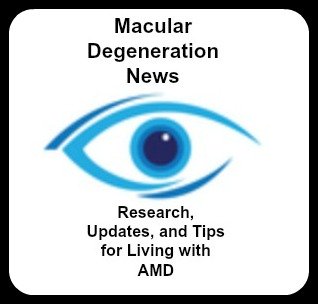Macular Degeneration Glasses for Distance
Macular degeneration glasses for distance vision are as important as magnifiers are for reading. These glasses make it possible to watch TV, recognize faces, see street signs, enjoy a play, are cheer for your favorite sports team.
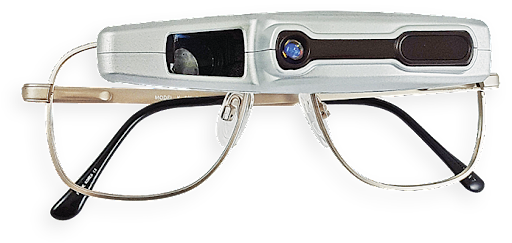
The macula, the central part of our retina is responsible for seeing detail—it’s the part of the eye that give us our normal “20/20 vision.” Macular degeneration, diabetes as well as other retinal and optic nerve disorders reduce the ability of the macular to function, and hence sharp central vision becomes reduced.
Individuals with reduced vision are said to have “Low Vision” which is usually defined as visual acuity of less than 20/70 that does not respond to medication, surgery, eyeglasses or contact lenses. While new treatments for macular degeneration hold great promise in controlling the progression of the disease sometimes even improving some of the vision loss, treatment is not yet able to return vision to normal.

Despite the vision loss experienced from macular degeneration, the world will not go dark. Peripheral vision remains normal allowing individuals to walk and engage in many normal activities. Our peripheral vision is sensitive to motion and works best in low light but it does not provide the sharp vision needed for reading and other fine detail tasks.
But in addition to allowing us to read, our vision serves also as an important social sense. Distance vision allows us to see faces, make eye contact, read body language and feel connected with the world around us. A reduction in distance vision has been associated with feelings of isolation and recent studies have shown that it can lead to depression.

There is a large range of vision assistive devices (low vision aids) designed to help individuals maximize their remaining vision. These include very strong eyeglasses, optical and electronic magnifiers, special software, and telescopic and digital devices that can be held in one’s hand or attached to conventional eyeglasses (Bioptics) or as virtual reality glasses (Head-Mounted Displays).
It is unlikely that one single aid will address all of the seeing needs for an individual. While many low vision aids can be found online and in catalogs the choices can be daunting. Visiting a low vision specialist to assess your vision and determine the appropriate devices is by far the most effective way to maximize one’s vision and independence.

Henry A. Greene, O.D., F.A.A.O. is an optometrist and the founder of Academy Eye Associates, and the co-founder of Ocutech, Inc, a company that develops innovative hi-quality bioptic telescopes for the visually impaired.
He is now a retired as a clinical professor in the Department of Ophthalmology at the University of North Carolina where he ran their Low Vision Service.

The Ocutech Falcon Autofocus Bioptic provides the most natural telescopic vision possible. They can help individuals with visual acuity of 20/300 and better.
As a researcher and developer in the field of low vision, he has been the principal investigator on National Eye Institute and Canadian Institute for the Blind funded projects to develop vision aids for those with macular degeneration and other eye conditions.
In 2008 he received the William Feinbloom Award from the American Academy of Optometry, given each year to a person who has made a significant contribution to the clinical advancement of visual and optometric service, and thus the visual enhancement of the public.
Perhaps you have never heard of bioptic telescopes and how these special glasses designed for individuals with macular degeneration (and other types of central vision loss) can help you see better. Find out more as Dr. Greene explains how they work and who can benefit from these glasses through this e-interview with WebRN Macular Degeneration readers.
Interview with Co-Founder of OcuTech - Bioptic Glasses
Bioptic Telescopes
1. Tell us how bioptic telescopes work and how they are useful for distance vision.
When vision is affected due to macular degeneration, glaucoma, diabetes, optic atrophy, albinism, nystagmus, or other hereditary or acquired visual disorders, central vision, which is responsible for enabling us to see details, is reduced. Conventional eyeglasses or contacts no longer help because the retina or optic nerve cannot produce a clear image, not because the image is out of focus, although it may certainly appear that way.
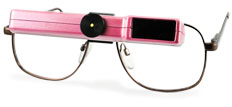
A manual focusing Keplerian telescope
They are even available in colors to make them more fun to wear.
Not only is reading difficult, but seeing signs, faces, TV and the computer are also impaired. While magnifiers and large print can help reading, only moving closer or using miniature telescopes can help you to see better at midrange distances or beyond.
Reading is usually done at home or in isolated situations. Distance vision, however, is often a public activity, and impacts social interaction and hence quality of life.
The loss of the ability to see the world around you, read body language and make eye contact can be isolating and can contribute to depression amongst the visually impaired. Telescopes help by making the image larger, allowing the user to see things further away. For instance, if an individual can only see a loved one’s face no further than 5 feet away, when looking through a 4x power telescope they may now be able to see their face from 20 feet away.
When a miniature telescope is attached to the top of a pair of eyeglasses it is called a bioptic telescope. By attaching the telescope to the eyeglasses, the wearer can switch their sight between their "regular vision" and the “magnified vision” through the telescope by just a slight downward tilt of the head—like ‘upside-down bifocals.’ Bioptic telescopes can be worn just like a regular pair of eyeglasses, are fast and convenient to use, and become automatic in short order.
2. What activities would a person use these telescopes for?
The Falcon autofocus bioptic can allow you to see clearly at any distance so that your hands can be free to do other things.
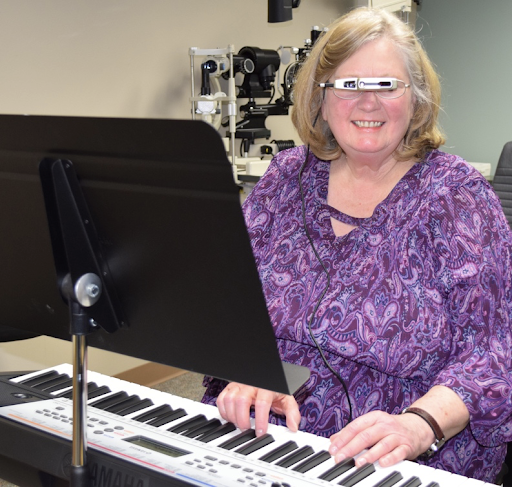
In the US, over 45 states allow eligible individuals to obtain or retain their driver’s license with use of a Bioptic Telescope. Consult your low vision specialist and understand your state’s regulations regarding Bioptic driving.
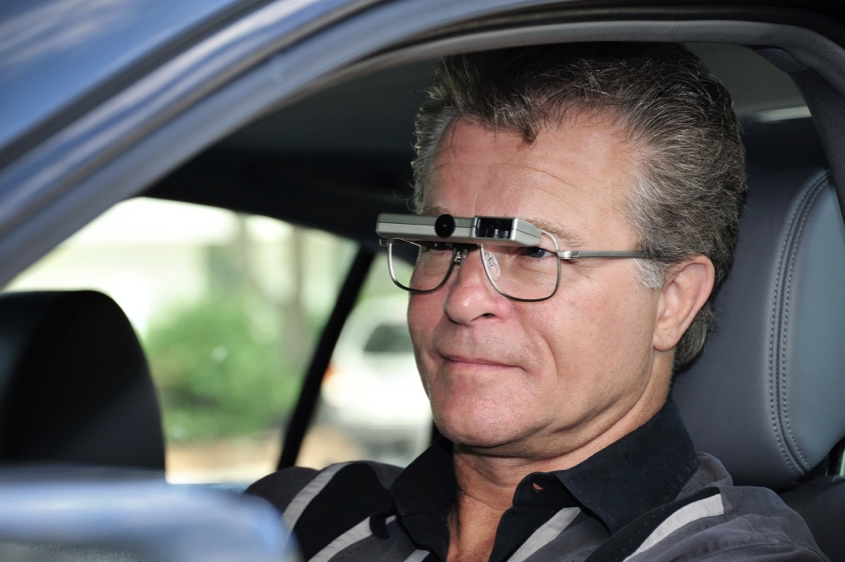
Bioptic telescopic systems can be helpful for viewing television, movies and theater, seeing faces, signs, blackboards in school, shopping, traveling, table-top activities including card and game playing, and mid-range activities such as reading music and the computer. Bioptic telescope users have even used their devices to drive, hike, golf, bowl, paint, fish and mow the lawn.
But, perhaps most importantly, it allows individuals to feel more connected to the world around them, so, when someone says, “Wow, look at that!” you can say “Yes, I can see it too!”
3. Are there different kinds of bioptic telescopes? What features should one look for in
selecting telescopic glasses for improving distance vision?
Bioptics can be broadly organized into two optical categories—Keplerian and Galilean. They are available in a range of magnification powers, and are prescribed based upon the level of vision and visual goals of the individual.
1. Keplerian Telescopes
Keplerian telescopes use a complicated combination of lenses and prisms to produce the widest field of view and sharpest edge-to-edge image possible. They are available as both manual focusing and autofocusing versions. They are most frequently prescribed in a 4x power, though powers from 3x to 6x are avaiable.
2. Galilean Telescopes
Galilean telescopes contain fewer lenses and no prisms making them smaller and lighter, but since they provide a narrower field of view and less edge sharpness they are most valuable in lower magnification powers. They are most frequently prescribed in a 2.2x power.
Studies have shown that the most important features of bioptic telescopes are:
field of view,
weight,
appearance and
ease of focus.
As telescopes increase in power, they increase in length and their fields of view decrease in size. In lower powers (2x to 3x) Galilean optical designs can provide ample fields of view for most purposes, however above 3x the wider fields of view of Keplerian optical designs are usually preferred.
4. How would someone with macular degeneration benefit from bioptic telescopes? Who is a candidate for distance glasses?
As mentioned above, telescopes help by making the image larger, allowing the user to see things further away. Many bioptic telescopes can be focused for different distances enabling them to be used for
distance,
mid-range, and
near magnification purposes.
Individuals with visual acuity as poor as 20/400 (6/120) have found bioptics to be helpful. The individual's specific visual needs, established in consultation with their low vision specialist, will determine which device and power will be most appropriate to achieve their functional goals.
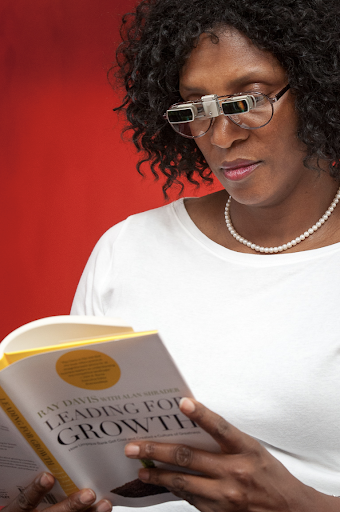
Ocutech has devised a simple questionnaire to help individuals with vision loss determine if they might be a promising candidate for bioptic telescopes.
If they can answer YES to the following questions than an evaluation by a low vision specialist would be the next step:
• Is your vision loss due to macular degeneration or a similar disorder that causes a loss of central, detail vision?
• Is vision in the better eye with your best eyeglass prescription (if used) 20/400 (6/120) or better?
• Can you read headlines on a newspaper with your regular reading glasses?
• Can you watch TV or recognize people's faces from further than 2 feet away?
• Do you understand that this device is designed to help you see better at distance and midrange for faces, signs, TV, computer screens, shopping and traveling?
5. What makes Ocutech bioptic telescopes different from other brands that may be available?
Ocutech’s Keplerian optical designs, called VES systems, are an innovative combination of telescopic and periscopic optics.
Researched and developed with funding from the National Eye Institute (NIH) they are designed to address the needs of users by providing a wide field of view, light weight, bright and sharp optics, and an appealing design.
They are the only Keplerian bioptic telescopes that offer this combination of features that experienced users prefer, and the only product that is available in an autofocus version. Low vision specialists prefer Ocutech bioptics because they are easy and convenient to demonstrate and fit, and they can be readjusted at any time.
6. How can someone with macular degeneration try these glasses to find out if they would be helpful to them? Where can one get them?
They should consult their low vision specialist or contact Ocutech at 800-326-6460 for the name of an Ocutech prescriber convenient to them. Ocutech’s website www.Ocutech.com offers a wealth of information, videos, and personal stories from actual users to help individuals better understand how Bioptics can help maximize vision.
7. What is the cost range of this type of macular degeneration glasses and does insurance or Medicare pay for them?
Ocutech systems range in cost from under $1000 to several thousand dollars depending upon the device, the customization charges, and accessories. These costs may not include professional fees for the low vision evaluation, the fitting and dispensing of the device or training sessions to help users become proficient in its use.
While health insurance often covers examination fees, Medicare does not usually cover the costs of low vision aids, while other private insurance or social service agencies and even employers may. For more information, contact your low vision specialist.
Go from Macular Degeneration Glasses to Vision Aids for Macular Degeneration
Go from Macular Degeneratin Glasses to WebRN Macular Degeneration Home
√ Prevention of Macular Degeneration?
√ Tips for Daily Living?
√ Food Suggestions for a Macular Degeneration Diet?
√ Ideas on Visual Aids to Maximize your Sight?
If you said "yes" to any of the above, sign up for the monthly Macular Degeneration News.

